Art is a way of sharing the way we see the world; it is an expression of our thoughts, emotions, intuitions, and desires. Art is how we connect with others and transcend the barriers of language, age, location and time. We need art because it makes us complete human beings. | I do not own the copyright to any of the images or content here published, they are in the public domain and I do not profit from them.
Don't wanna be here? Send us removal request.
Text
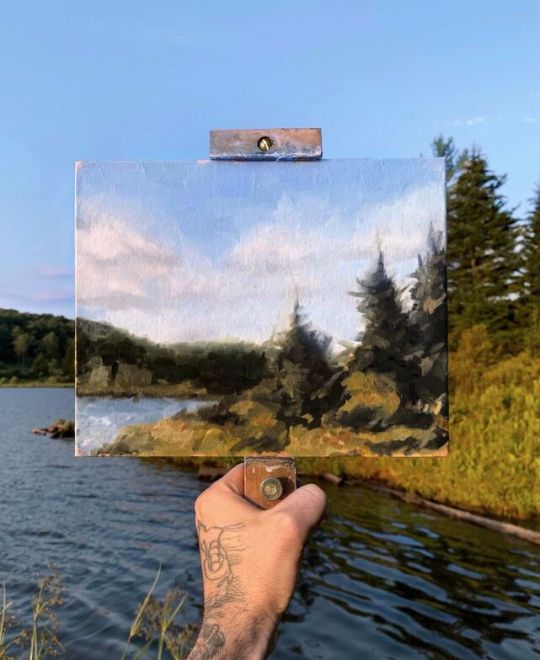

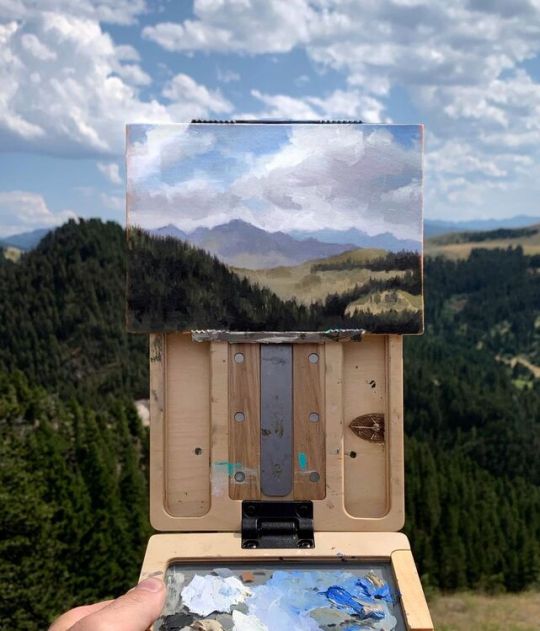
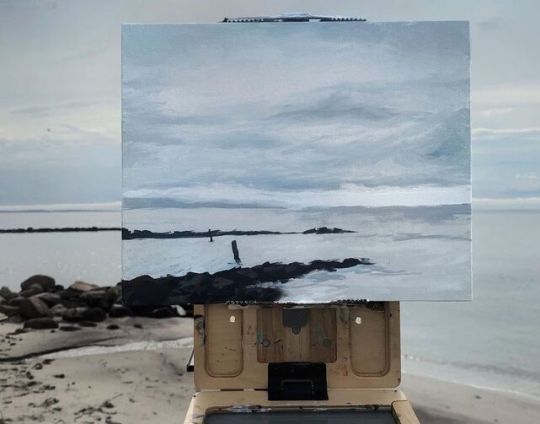
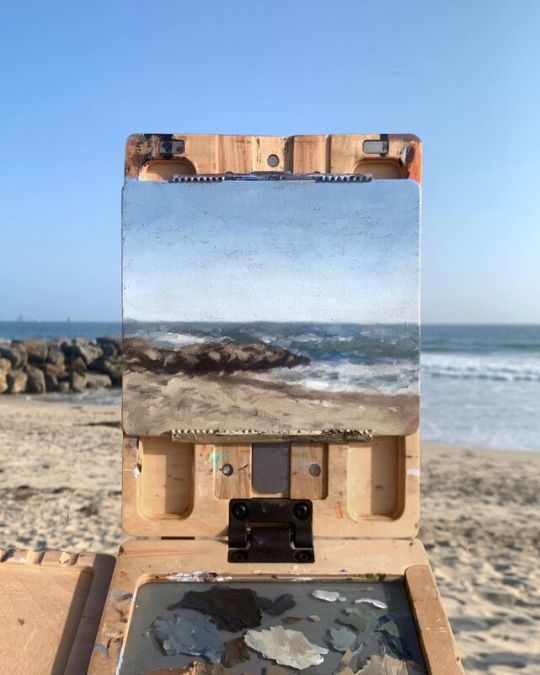
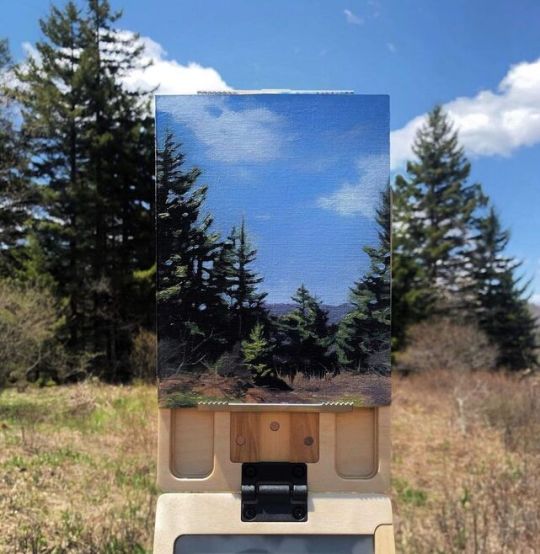
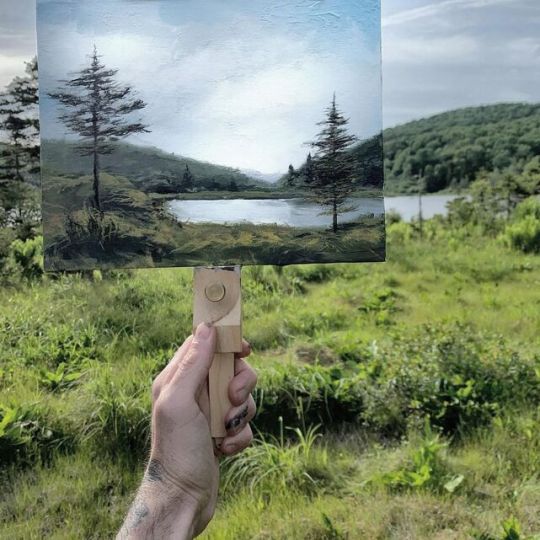
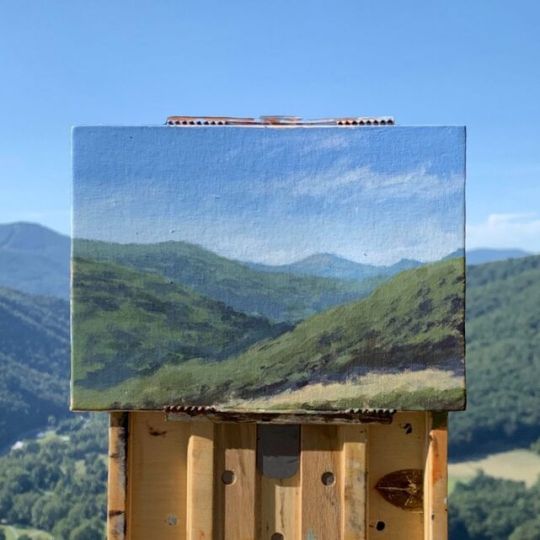
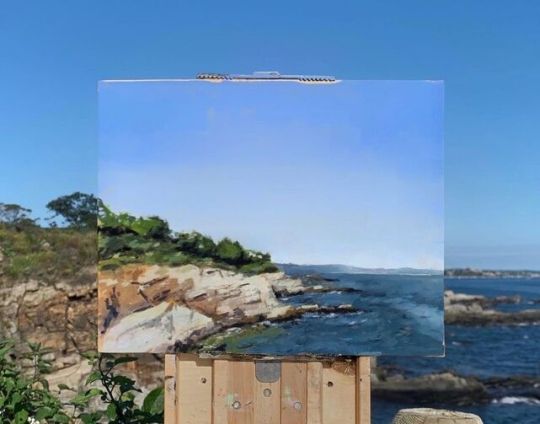
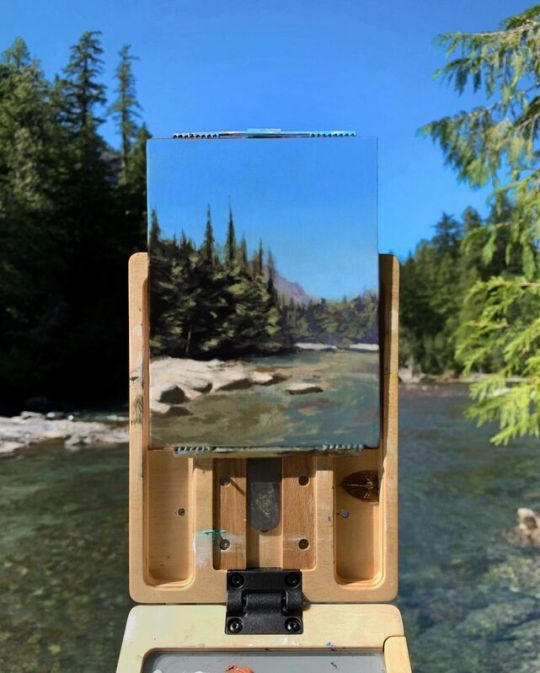
Remember that when you are at the bottom of the abyss, a simple movement is a breakthrough. Mike Adams Fine Art
7K notes
·
View notes
Photo

The Pianolesson, oil on panel, 1897
by Henriette Ronner-Knip (Dutch-Belgian, 1821-1909)
51K notes
·
View notes
Text






male nude - gustav klimt (1880) // 9x01 // the dying gladiator - pierre julian (1799) // patroclus - jacques-louis david (1780) // 9x03 // male back with flag - michelangelo (1504)
41K notes
·
View notes
Text
Add Fuel.








I'm almost bothered by the fact that I wasn't aware of Add Fuel's work until a few weeks ago because it's so damn good.
Add Fuel is Portuguese artist Diogo Machado who, through his work, creates balance and harmony from symmetrical repetitions, a build-up of layers and techniques of visual illusion such as trompe-l'œil. His multi-layered patterned compositions produce a poetic rhythm that plays with the viewer's perception and the (multiple) possibilities of interpretation.
Exploring a wide range of both manual and digital techniques in the fields of drawing, painting, ceramics and printing, his practice expresses a sophisticated dialogue between the old and the new, between heritage and modernity.
-
SHOP | FOLLOW ON INSTAGRAM!
2K notes
·
View notes
Photo

Chand Baori, the largest and deepest stepwell in India. It consists of 3500 narrow steps over 13 stories and extends 30 m into the ground. The oldest parts of the stepwell date from the 8th century, while the upper stories with the columned arcade around it were built in the 18th century.
1K notes
·
View notes
Photo
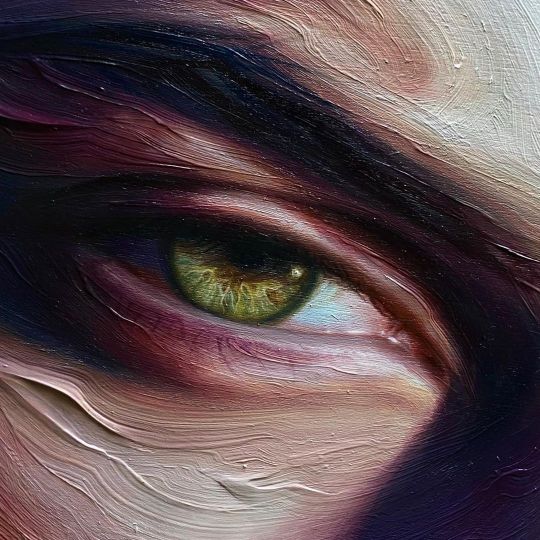
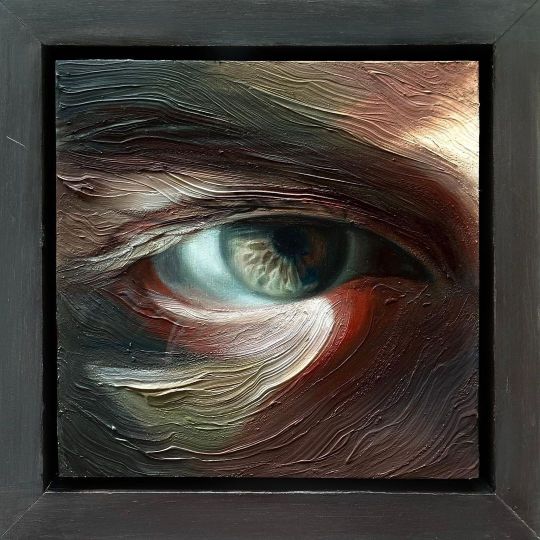

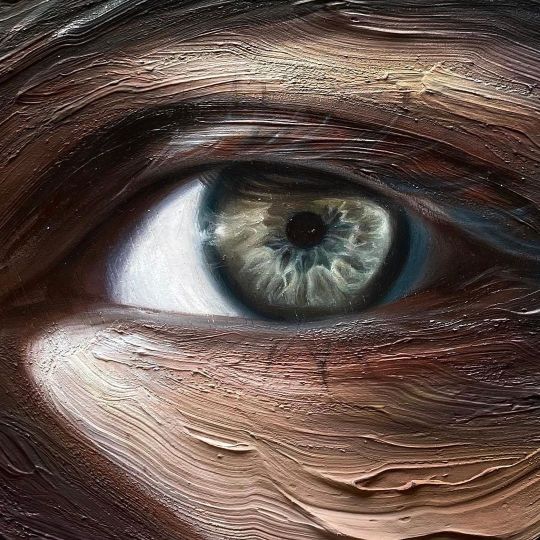
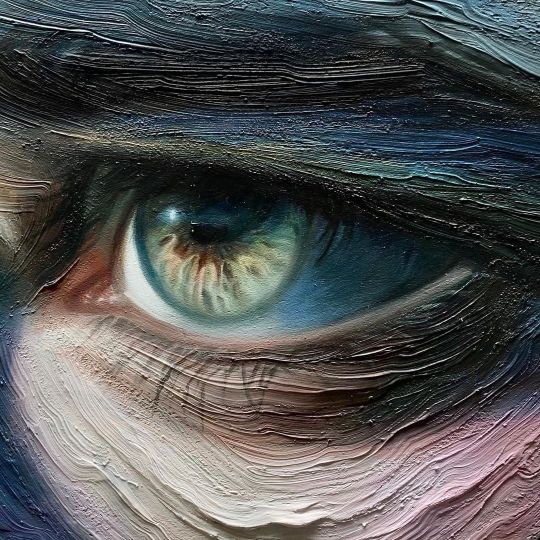
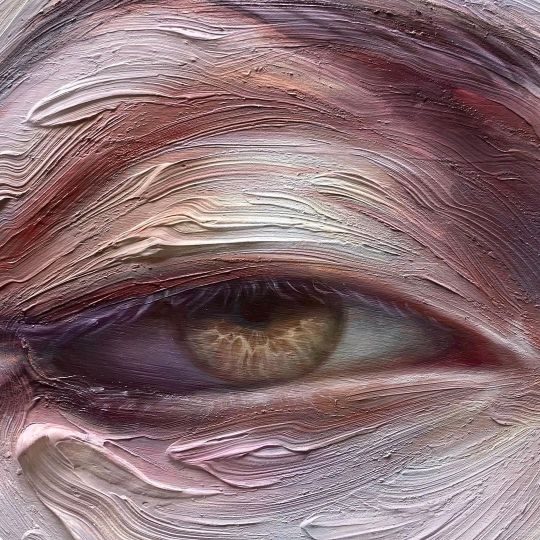
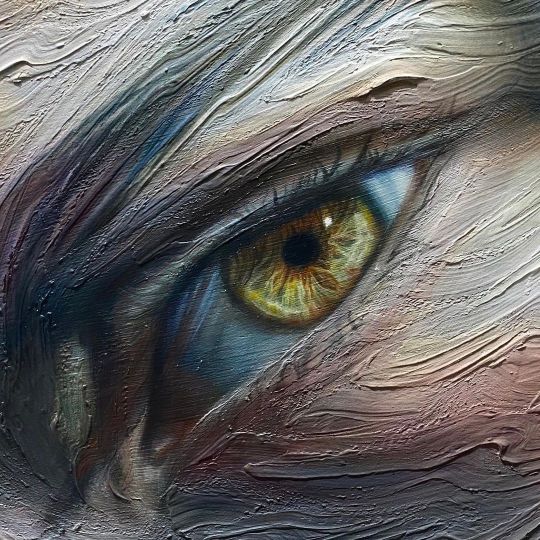
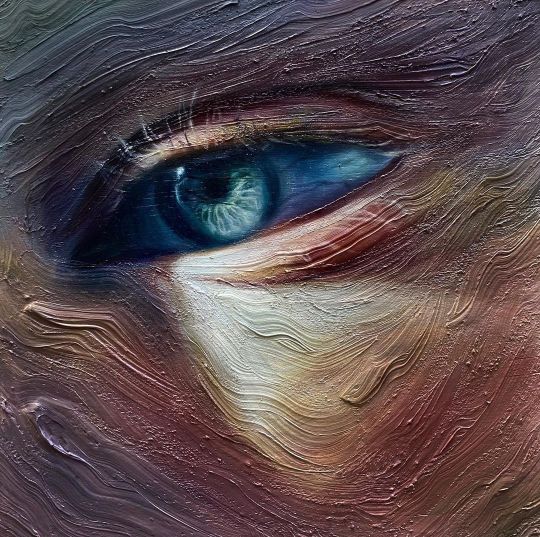
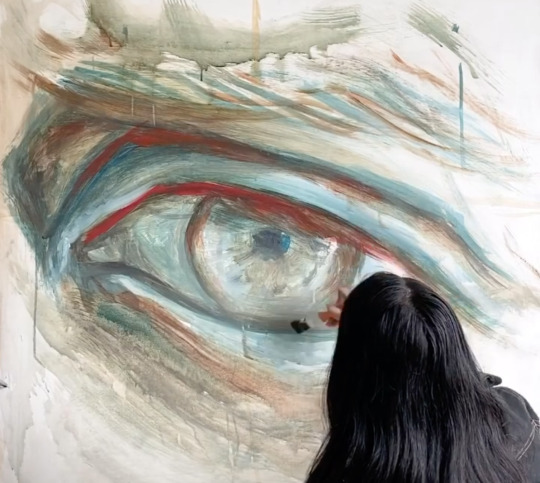
Maldha Mohamed.
Astounding paintings that combine realism and texture by artist Maldha Mohamed, who lives and works in Maldives.
-
Be sure to follow Supersonic Art on Instagram!
26K notes
·
View notes
Text
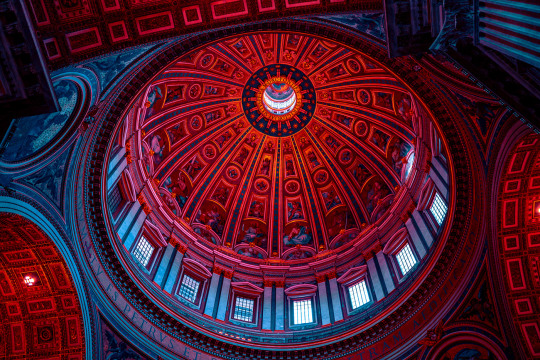
Red Lights - Vatican Aishy
Discover The Basilica di San Pietro, in the heart of the Vatican, under a new glance, a new light. Tinged with red and blue, it changes its appearance and offers a new vision.

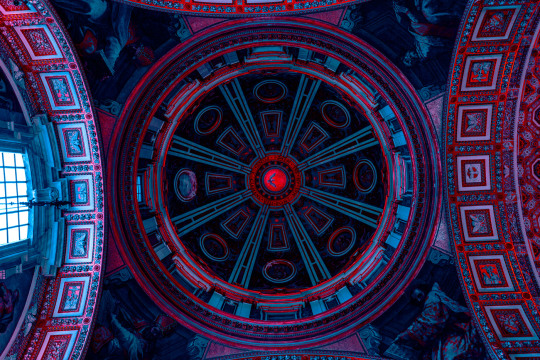
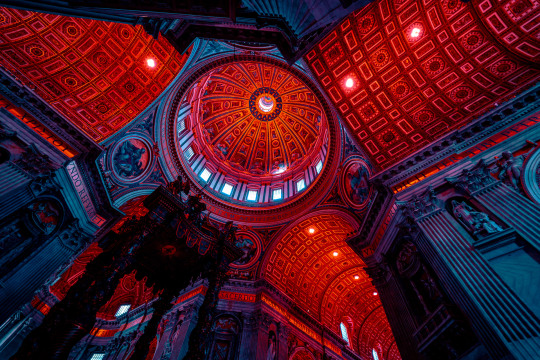





12K notes
·
View notes
Photo

Korea, Joseon dynasty (1392-1910) - Amitabha Triad 금동아미타여래삼존좌상 (金銅阿彌陀如來三尊坐像), the 1400s.
This rare bronze triad from the 1400s shows Amitabha (아미타불 in Korean), or the Buddha of the Western Paradise, seated on a lotus pedestal at the centre. He is flanked by two sacred attendants, Ksitigarbha (지장보살 in Korean) on his left and Avalokitesvara (관음보살 in Korean) on his right. The combination of these three Buddhist deities was particularly popular in the early Joseon period. The small scale suggests that this triad might have been displayed in a personal shrine rather than a large worship hall.
Credit: The Cleveland Museum of Art
Art Through Time
#korea#joseondynasty#joseon dynasty#amitabha#bronze#gilding#1400s#15th century#fifteenth century#korean art#sculpture#bronze sculpture#buddhist#금동아미타여래삼존좌상#金銅阿彌陀如來三尊坐像#아미타불#지장보살#관음보살
6 notes
·
View notes
Photo

Medieval Art - Table Fountain, ca. 1320-1340.
France, Paris.
Fun Fact: This fountain with its minute architectural details and finely made enamel plaques displayed the wealth and refinement of the owner as it entertained his guests. Imagine hearing the ringing of the tiny bells when this fountain was in use.
Conceptually and stylistically, this object is beyond all else a piece of Gothic architecture in miniature with vaults, pinnacles, columns, and traceried arches. Though the artist who created it is unknown, he was unquestionably inspired by the great Gothic buildings of his time. The table fountain is a three-tiered assembly combining cast elements with bent sheets of gilt-silver. To these have been attached a series of enamel plaques representing grotesque figures, some of which play musical instruments. Water wheels and bells were added to capture motion and sound. The rich detail, precious materials, and involved ornamentation of this deluxe object suggest it would have been expensive to produce and highly treasured by its original owner, someone of high status, and would have been deployed as an object of spectacle. This is the most complete example of its type known to survive from the Middle Ages. Medieval inventories reveal that small fountains like this, often taking various forms, and generally made from precious metals, once existed in large numbers, thus making the Cleveland table fountain an extremely rare object.
Credit: The Cleveland Museum of Art
Art Through Time
#medieval art#france#paris#14th century#fourteenth century#gilt-silver#translucent enamels#gothic sculpture#gothic painting#metalwork#gothic#silver#precious material#middle ages#The Cleveland Museum of Art
45 notes
·
View notes
Photo

African Art - Throwing Knife, the 1800s.
Central Africa, Democratic Republic of the Congo, Mangbetu.
Forged iron and wood.
Credit: The Cleveland Museum of Art
Art Through Time
#african art#arms and armor#forged iron#wood#1800s#19th century#nineteenth century#central africa#democratic republic of congo#mangbetu#knife#The Cleveland Museum of Art
7 notes
·
View notes
Photo

Islamic Art - Prayer Niche (Mihrab), the early 1600s.
Iran, Isfahan.
The prayer niche (mihrab in Arabic) is the focal point in the interior of a mosque. It is located in the qibla wall which is oriented toward Mecca, the holy city of Islam. Muslims face the qibla wall during prayer. This mihrab is an excellent example of different design elements-calligraphy, plants, and geometry-integrated into a beautiful harmonious whole. Graduated colours and sizes contribute to its success. The dominant white glaze presents the most important verses from the Qur’an written in elegant thuluth script which frames the niche. White glaze also outlines geometric patterns and arabesque vines. The less conspicuous turquoise glaze forms secondary designs such as curving vines behind the stunning calligraphy. Curved and straight lines are juxtaposed, enhanced with additional colours of mustard-yellow and aubergine on the deep blue ground. The design is formed with individual pieces of tile in the ceramic mosaic technique. Segments are cut according to the pattern from monochrome tiles with a chisel and their edges smoothed with a file. The pieces are then arranged face down according to a pattern and covered with plaster in manageable sections to install. Since colourful ceramic mosaic decorates many old buildings in Iran, modern craftsmen have become skilled in their workmanship and ongoing maintenance. The style and design in this mihrab, which developed during the 1500s, continues to the present day. Translation of Calligraphy on the Mihrab The Qur’anic inscription around the mihrab is from the Chapter of Light (24:35): God is the light of the Heavens and the Earth. His Light is like a niche in which is a lamp-the lamp enclosed in glass-the glass, as it were, a glistening star. From a blessed tree it is lighted, the olive neither of the East nor of the West, whose oil would well neigh shine out, even though fire touched it not! It is light upon light. God guideth whom He will to His light, and God setteth forth parables to men, for God knoweth.
Credit: The Cleveland Museum of Art
Art Through Time
#prayer niche#mihrab#Islamic Art#iran#isfahan#ceramic mosaic#arabic#arabic art#mecca#muslims#coran#ceramic#gold#turquoise#mustard#monochrome#tiles#17th century#seventeenth century#1600s#1600s art#The Cleveland Museum of Art
5 notes
·
View notes
Photo

China, Eastern Zhou dynasty (770-256 B.C.), Spring and Autumn period (770-476 B.C.) - Food Container (Gui), 600-500 B.C.
Openwork and sculptural designs elaborately transform the silhouette of this gui, a ritual food vessel with a square pedestal. The design exudes motion, exuberance, and baroque characters to a stately vessel form. Lotus-petal openwork encircles the cover, reinforcing the linear rhythms of the undulating wave patterns on the body. Two lively dragons, with eyes and mouth wide open and tongue straight out, are accompanied by two felines to form the arched handles.
Credit: The Cleveland Museum of Art
Art Through Time
#china#zhou dynasty#spring and autumn period#bronze#arts of ancient china#chinese art#metalwork#food container#sculpture#gui#lotus#dragons#The Cleveland Museum of Art
3 notes
·
View notes
Photo

Winslow Homer - Dressing for the Carnival, 1877.
Produced one year after the official failure of Reconstruction—the withdrawal of federal troops from the South—Homer’s challenging subject evokes both the dislocation and endurance of African American culture that was a legacy of slavery. The central figure represents a Jonkonnu character, a Christmas holiday celebration once observed by enslaved blacks in Virginia and North Carolina. Rooted in the culture of the British West Indies, the festival blended African and English traditions. After the Civil War, aspects were incorporated into African American Independence Day celebrations, to which the painting’s original title, Sketch—4th of July in Virginia, referred.
Credit: The Metropolitan Museum of Art
Art Through Time
#winslow homer#19th century#nineteenth century#american#1800's#oil on canvas#painting#oil painting#canvas#american art#daily life#dance#music#civil war#4th of july#viriginia#United States#the Met#The Metropolitan Museum of Art
5 notes
·
View notes
Photo

Fitz Henry Lane (formerly Fitz Hugh Lane) - Stage Fort Across Gloucester Harbor, 1862.
Lane returned to his native Gloucester from Boston in 1848. His works of the 1850s and 1860s are successively purged of genre and topographical elements, becoming increasingly spare and essential. By 1862, Lane had engineered a seamless, self-effacing style, possibly influenced by the works of Martin Johnson Heade. Stage Fort, once the site of military fortifications, sits on an arching landform used to lead the viewer's eye into the glowing, lucid, and almost eerily still distance. Despite the disjuncture between the virtually surreal, meticulously painted foreground and the sheer plane of water near the horizon, this work marks the transition to Lane's final, taut, elemental style. The painting's disquieting stasis, even with its hopeful pink and golden glow, creates a hermetic, elegiac mood found in many of Lane's late works.
Credit: The Metropolitan Museum of Art
Art Through Time
#fitz henry lane#fitz hugh lane#19th century#nineteenth century#american#oil on canvas#painting#oil painting#canvas#american art#hudson river school#landscape#luminism#north america#seascape#United States#the Met#The Metropolitan Museum of Art
2 notes
·
View notes
Photo
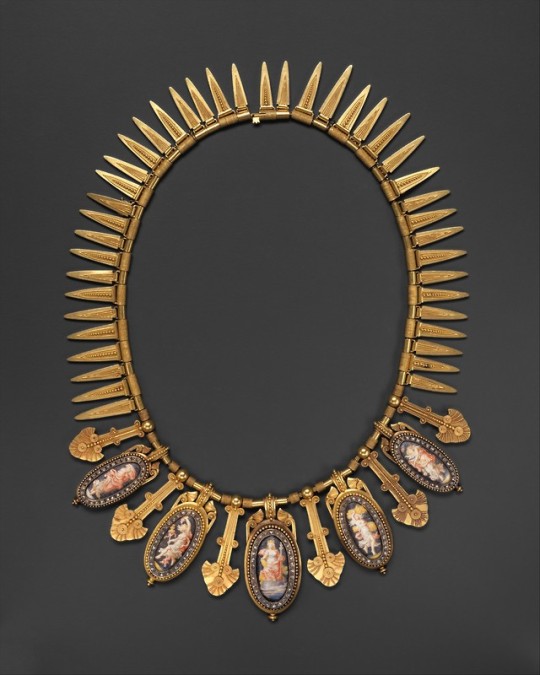
Eugêne Fontenay - Necklace, ca. 1870.
This gold chain has five oval enameled pendants depicting personifications of Europe and the Seasons. Each oval is framed in diamonds interspersed with long stylized palmette-shaped pendants, and forty-one leaf-shaped pendants, decorated with granulation and wirework suspended from alternately plain and coiled tubular links. The use of granulation and images of classical maidens, as well as the overall organization, demonstrate the designer's dependence upon ancient Greek gold jewellery for inspiration. Like the Castellani firm in Rome, Eugène Fontenay reproduced jewellery in ancient Greek, Roman, and other historical styles. However, not only did Fontenay copy period originals, he also took motifs from these styles and, with them, created original designs.
Credit: The Metropolitan Museum of Art
Art Through Time
#eugêne fontenay#19th century#nineteenth century#french#paris#gold#enamel#diamonds#metalwork#platinum#jewelry#decorative arts#europe#france#european decorative arts#jewellery#metal#necklace#pendant#personal ornament#precious sto#seasons#stone
45 notes
·
View notes
Photo

William Merritt Chase - Carmencita, 1890.
Carmencita, the dancer known as the “Pearl of Seville,” was born in 1868 in Almería, on the southeastern coast of Spain, and became famous in her home country and in France during the 1880s. After she made her New York debut in 1889 at Niblo’s Garden, she was besieged with requests for private performances. John Singer Sargent arranged for her to perform in Chase’s studio on the evening of April 1, 1890. Afterwards, Chase painted this lively portrait of the dancer, in which he suggested the audience’s enthusiasm by including the gold bracelet and flowers they had tossed at her feet. Sargent’s own portrait of Carmencita (also 1890) is in the Musée d’Orsay, Paris.
Credit: The Metropolitan Museum of Art
Art Through Time
#william merritt chase#19th century#nineteenth century#american#oil on canvas#painting#oil painting#american art#american impressionism#canvas#dance#music#new york#north america#portrait#united states#spain#the met#The Metropolitan Museum of Art
2 notes
·
View notes
Photo

Augustus Saint-Gaudens - Davida Johnson Clark, 1886.
This graceful underlifesize portrait of Davida Johnson Clark (1861–1910) was a gift from Saint-Gaudens to his longtime model and mistress and the mother of his second son, Louis (b. 1889). The private token of affection also served as an early study for the head of Diana for the tower of Madison Square Garden, the most public of Saint-Gaudens’s outdoor sculptures. An over-lifesize cast of Diana is on view in the Charles Engelhard Court of the American Wing.
Credit: The Metropolitan Museum of Art
Art Through Time
#augustus saint-gaudens#19th century#nineteenth century#american#plaster#shellac#sculpture#american art#american decorative arts#decorative arts#neoclassicism#north america#portrait#preparatory study#sculpture in the round#united states#the met#The Metropolitan Museum of Art
2 notes
·
View notes